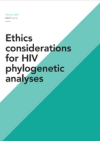What's New
Displaying results 21 - 30 of 4914
Resource | Presentations,
Get an overview of the HIV/AIDS situation in Timor-Leste. Browse and view charts and graphs illustrating data on the country's basic socio-demographic indicators, HIV prevalence and epidemiology, risk behaviors, vulnerability and HIV knowledge, HIV expenditures, and national response.
Resource | Presentations,
Get an overview of the HIV/AIDS situation in the Philippines. Browse and view charts and graphs illustrating data on the country's basic socio-demographic indicators, HIV prevalence and epidemiology, risk behaviors, vulnerability and HIV knowledge, HIV expenditures, and national response.

Resource | Publications,
A new report, HIV Prevention: From Crisis to Opportunity shows that HIV infections continue to decline in countries that are part of the Global HIV Prevention Coalition (GPC) faster than in the rest of the world.
Eleven GPC focus countries have reduced their annual number of new HIV infections by at least 66% since 2010. By comparison, the average reduction in new HIV infections since 2010 globally is 38%. The GPC is a coalition of 38 countries working together to accelerate declines in new HIV infections to achieve the target of having 95% of the people who are at risk of HIV accessing effective combination prevention options.

Resource | Publications,
The Global Fund strategy for 2023-2028 has three mutually reinforcing contributory objectives. One critical objective is Maximizing the Engagement and Leadership of Most Affected Communities to Leave No One Behind, which specifically applies to GC7.
Resource | Presentations,
Get an overview of the HIV/AIDS situation in Papua New Guinea. Browse and view charts and graphs illustrating data on the country's basic socio-demographic indicators, HIV prevalence and epidemiology, risk behaviors, vulnerability and HIV knowledge, HIV expenditures, and national response.
Resource | Presentations,
Get an overview of the HIV/AIDS situation in Pakistan. Browse and view charts and graphs illustrating data on the country's basic socio-demographic indicators, HIV prevalence and epidemiology, risk behaviors, vulnerability and HIV knowledge, HIV expenditures, and national response.
Resource | Presentations,
Get an overview of the HIV/AIDS situation in Nepal. Browse and view charts and graphs illustrating data on the country's basic socio-demographic indicators, HIV prevalence and epidemiology, risk behaviors, vulnerability and HIV knowledge, HIV expenditures, and national response.
Resource | Presentations,
Get an overview of the HIV/AIDS situation in Japan. Browse and view charts and graphs illustrating data on the country's basic socio-demographic indicators, HIV prevalence and epidemiology, risk behaviors, vulnerability and HIV knowledge, HIV expenditures, and national response.
Resource | Presentations,
Get an overview of the HIV/AIDS situation in India. Browse and view charts and graphs illustrating data on the country's basic socio-demographic indicators, HIV prevalence and epidemiology, risk behaviors, vulnerability and HIV knowledge, HIV expenditures, and national response.

Resource | Publications,
Ethics is a discipline or area of study concerned with issues such as benefits, harms, fairness, and rights. As an area of study and practice, ethics covers moral values and questions about what actions should be taken and which policies should be implemented. Ethical answers to these questions depend on what (beneficial or harmful) outcomes are likely to occur, but also the extent to which these outcomes will be distributed fairly through relevant populations, and the rights and interests of the people affected by actions and policies. This is the third brief in a set discussing phylogenetics and HIV in public health will discuss ethics and human rights considerations.
Throughout, we keep in mind Article 8 of the Helsinki Declaration: While the primary purpose of medical research is to generate new knowledge, this goal can never take precedence over the rights and interests of individual research subjects.





